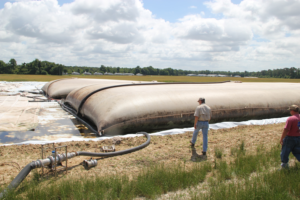Sludge Bags or Geotextile Tubes to Dewater Sludge
go.ncsu.edu/readext?451034
en Español / em Português
El inglés es el idioma de control de esta página. En la medida en que haya algún conflicto entre la traducción al inglés y la traducción, el inglés prevalece.
Al hacer clic en el enlace de traducción se activa un servicio de traducción gratuito para convertir la página al español. Al igual que con cualquier traducción por Internet, la conversión no es sensible al contexto y puede que no traduzca el texto en su significado original. NC State Extension no garantiza la exactitud del texto traducido. Por favor, tenga en cuenta que algunas aplicaciones y/o servicios pueden no funcionar como se espera cuando se traducen.
Português
Inglês é o idioma de controle desta página. Na medida que haja algum conflito entre o texto original em Inglês e a tradução, o Inglês prevalece.
Ao clicar no link de tradução, um serviço gratuito de tradução será ativado para converter a página para o Português. Como em qualquer tradução pela internet, a conversão não é sensivel ao contexto e pode não ocorrer a tradução para o significado orginal. O serviço de Extensão da Carolina do Norte (NC State Extension) não garante a exatidão do texto traduzido. Por favor, observe que algumas funções ou serviços podem não funcionar como esperado após a tradução.
English
English is the controlling language of this page. To the extent there is any conflict between the English text and the translation, English controls.
Clicking on the translation link activates a free translation service to convert the page to Spanish. As with any Internet translation, the conversion is not context-sensitive and may not translate the text to its original meaning. NC State Extension does not guarantee the accuracy of the translated text. Please note that some applications and/or services may not function as expected when translated.
Collapse ▲Sludge bags or geotextile tubes are gaining in popularity as a way to dewater sludge. The bags are used as an alternative method to traditional pump and haul to remove sludge in a lagoon. The bags are constructed from high-strength permeable geotextiles. The porous fabric only allows water to escape. The bags are resistant to biological, chemical and UV degradation for 5-7 years. The finished product is easier to transport, can be stored and used later, and has low odor. The bags allow a farmer to target a critical area in the lagoon, such as near the intake. There is the potential for a marketable final product. You will need approval from the Division of Water Resources (DWR) animal division. Price comparison is needed to make sure that this will benefit your farm’s situation. Consider cost of equipment, polymers and distance to receiving land. This article will give a brief overview of the process. Contact your Extension Agent for more information.
Some materials and equipment needed:
- geotextile tubes (30 to 90’ in circumference and any length usually 25-100’)
- dredge to remove sludge and water from the lagoon
- pumps and piping – system needs to be able to add polymer before the pump, after the pump, and a special pump. Injection point is important. Some lagoons need more mixing, so need a pump to add polymer before mixing. Others need less, so put in polymer after the pump for less turbulence and mixing.
- solid separator
- flow meter gives total gallons per day
- frac tank mixes to have a consistent product and helps with polymer dosage rate.
- polymers and container to mix polymers. There are several polymer types to choose from (examples are aluminum sulfate, ferric sulfate, food grade polymers). The amount of polymer will influence the rate of dewatering and increase the rate and suspension of solids in the bag. Need correct ratio for proper flocculation.
This picture shows checking coagulation or flocculation to monitor polymer dosage. When the water runs clear and the solids stay in a ball means you are at the correct polymer dosage.
The picture below shows the bags. Sludge is mixed with polymer and pumped into the bags. Bags dewater and the solids stay in the bags. Bags are pumped full and allowed to dewater. This process continues until bags are completely full. Fill time is dependent on several factors – pump volume, dewater time, polymer effectiveness, etc. Rainfall can affect dewatering, not fill time.
Considerations:
Liner will catch water from the bags as it dewaters. Options include silage plastic or other plastics.
Slope and grade of the land are critical to ensure that water and storm water are pumped back into the lagoon. Flat or 0 slope going down and in the other direction should be ½ grade slope. Too much slope and bags can roll over because water travels to the low spot.
Storm water is a concern. It will collect on the liner and will have to be accounted for and pumped back into the lagoon.
Consider how you will pay for removal. Paying on dry matter tons is a fair way because there are different solid percent removal rates.
Bags cannot be reused to hold sludge, but can be taken to a landfill or used at construction sites.




